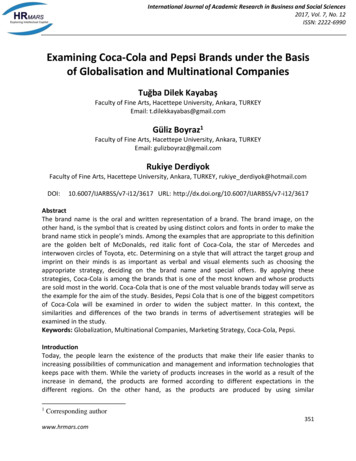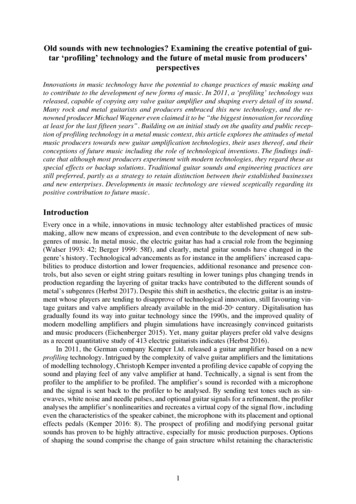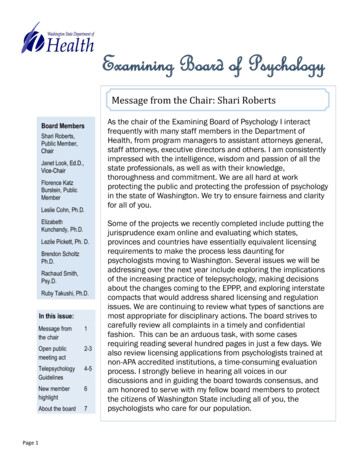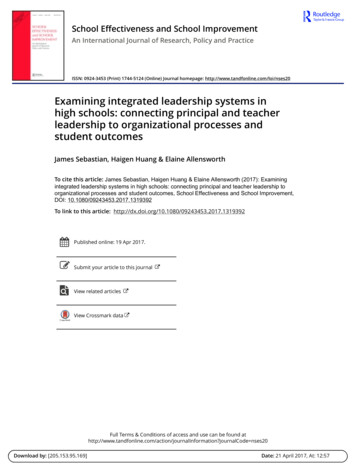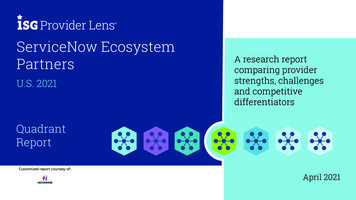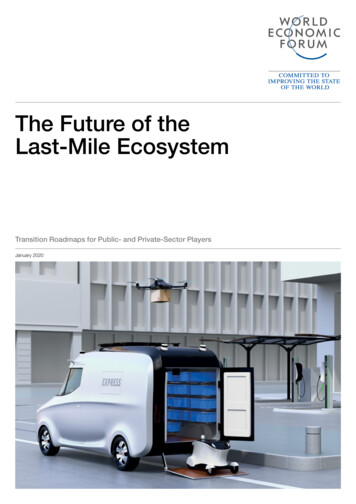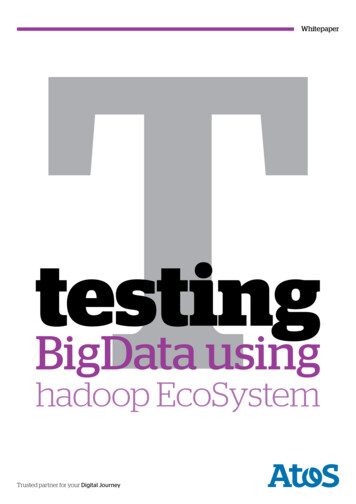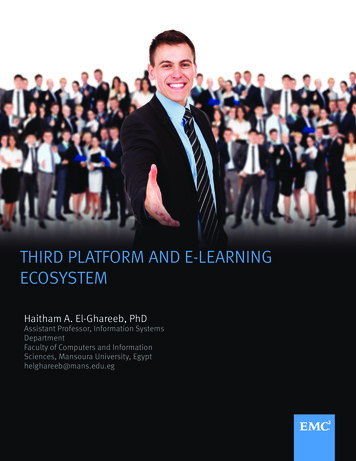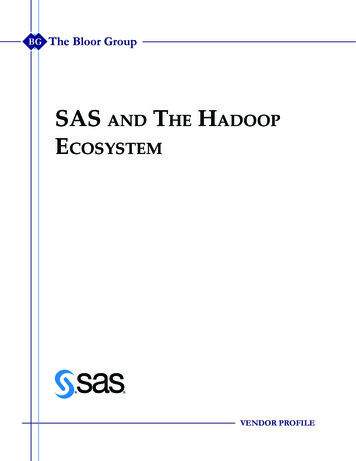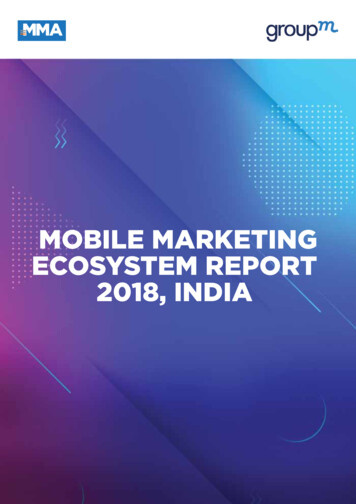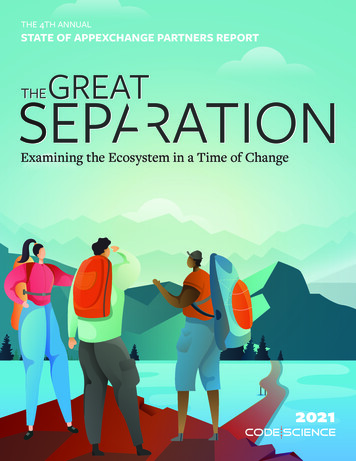
Transcription
THE 4TH ANNUALSTATE OF APPEXCHANGE PARTNERS REPORTExamining the Ecosystem in a Time of Change2021
Table of Contents3. Executive Summary11. Product & Company17. Growth23. Technology & Platform27. Salesforce as a Channel33. Diversity & Inclusion41. Investments (powered by Crunchbase)2
ExecutiveSummaryBackgroundThe launch of our 4th Annual State of AppExchange Partners Report coincides with a pandemicthat has fundamentally changed the lives and landscape of the world at large. Additionally, as apeople, we are confronting what it means to be diverse and inclusive as a society and within ourworkforces.We have continued to refine our survey to surface the most pertinent and impactful data partnersneed to understand the trends of the ecosystem and the performance of their peers.Over the past four years, the scope and shape of our report have changed. What started with therelease of our first report in 2017 at Dreamforce has grown to become our most requested asseteach year.Our State of AppExchange Partners Report provides an independent look at the SalesforceAppExchange and shares insights for those who are building their business there. In thisyear’s report, there are two main themes to which we’ll return—The Great Separation and theResilience of Partners within the ecosystem.The report is broken down into six sections, and you’ll discover how other AppExchange partnersare leveraging Salesforce in the following categories:1. Product & Company2. Growth3. Technology & Platform4. Salesforce as a Channel5. Diversity & Inclusion6. Investments (powered by Crunchbase)3
MethodologyAs in previous years, we gathered insight from around 100 senior-level executives, with 67% beingC-Suite or VPs from companies spanning the Fortune 5 to high-growth SaaS startups. Our respondent set continues to represent a solid cross section of the makeup of the AppExchange.HOW MANY YEARS HAVE YOU BEEN A SALESFORCE APPEXCHANGE 0%10%9%9%8% 8%6%6%5%5%5% 5%3%0%years12We are delightedto continue ourpartnership withCrunchbase fora second year toprovide an in-depthexamination of theinvestment landscapefor SaaS andSalesforce Partners.4345678910 Crunchbaseis the leading platformfor professionals to discover innovativecompanies, connect with the people behindthem, and pursue new opportunities. Over 50 millionprofessionals—including entrepreneurs, investors, marketresearchers, and salespeople—trust Crunchbase to informtheir business decisions. And, companies all over the world relyon Crunchbase to power their applications, making over abillion calls to our API each year.EXECUTIVE SUMMARY
The Great SeparationThroughout this year, we have seen companies that operate on the spectrum of surviving,adapting, and thriving. These categories have helped us contextualize the challenges businessesface, their priorities for investments, and the forecasts they are making for their future. This year’ssurvey went to ISVs across all spectrums of this framework, and the responses drove furtherresearch into what separates companies who are thriving from the rest.WNESThose companies that are thriving through COVID are growing faster than ever. They are lappingtheir competitors and are the dominant forces in their respective spaces. Amazon, Salesforce,Slack, Zoom—these winners are creating decades of lead beyond the rest of the pack, and theirgrowth doesn’t seem to be slowing down.There are three common characteristics underpinning companies that are thriving:1. They are repackaging existing technology into new solutions that solve the challengescustomers are facing.2. Said solutions are positioned as business continuity, rather than digital transformation.3. The companies are all investing heavily in R&D, Sales, and Marketing.5
EXPLORING THE APPEXCHANGE ECOSYSTEM UNCOVERS COUNTLESS EXAMPLES OFORGANIZATIONS FOLLOWING THIS SAME CRITICAL PATH TO A THRIVING STATE.#1 nCino#2 Skedulo#3 SalesforcenCino, which celebrated a massiveIPO in July of this year, followedthis same blueprint for success. After nine years of being in the market, their banking product is exceptionally mature and battle-tested.The nCino solution, while perfectlypositioned to help banks digitallyoriginate loans, required untenabledeployment times for banks duringCOVID. nCino’s CPO, Trisha Price,led the company in repackagingtheir technology to handle thespecific use case of the U.S. Government Paycheck Protection Program (PPP Loans)—a massive fundof over 500B. The new nCino SBAsolution, deployable in mere days,enables banks to originate SBA PPPLoans. And originate they did—thesolution processed approximately10% of the entire fund in less thanthree months. Repackaging existingtechnology as a business continuitysolution enables nCino to thrive.Skedulo has been enablingmobile workforces in theSalesforce ecosystem since2013. In the year before COVID,their CEO, Matt Fairhurst,recognized the strategic valuein providing scheduling, dispatching, shifts, and rosteringfor the mobile workforces theirproduct already supported.As COVID set in, he quicklyrealized that by repackagingtheir technologies together,they could provide a turnkeysolution for governments andbusinesses that needed tosupply COVID-19 tests. Theirsolution underpinned the NFL,NBA, MLB, New York City,and the city of Berkeley in thegargantuan tasks of handlingscheduling and coordinationof all COVID-19 tests. Repackaging existing technology asa business continuity solutionenables Skedulo to thrive.In many ways, Salesforce set thestage and provided the ultimateexample. Amid a global recession,selling Sales Cloud can be seen asquixotic. However, they leveragedthe same playbook, repackagingexisting technology to solve theexistential challenges that businesseshave faced. The Work.com suite,for both businesses and schools,provides the tools necessary forcompanies and schools to bringtheir people back—locationtracking, self-attestation, learning,smart workflows, and so muchmore. For the most part, thisfunctionality existed before andwas repurposed: self-attestationis Salesforce Surveys; learningis MyTrailhead; smart workflowsare Lightning Flows. Repackagingexisting technology as a businesscontinuity solution enablesSalesforce to thrive.
WNESThe leading companies in the ecosystem are thriving and separating from their competition.Researching publicly disclosed earnings, our survey responses, and the interviews with ISVs allback up this hypothesis. The drive to stay relevant and solve critical problems is sound operatingadvice. In 2020, however, this has led to the great separation of the market leaders from the restof the pack.The Resiliency of the EcosystemAs we look to the next segment of our framework—companies in the adapt segment—weexpected to see existing customer and financial challenges. We hypothesized that attrition(i.e., churn) would become a significant issue, with renewal rates decreasing throughout the year.Companies weren’t reporting that at all. In fact, the top three challenges are:1. Acquiring new customers2. Evolving our product offering3. Hiring new employeesAcquiring new customers has been the #1 concern for all four of the State of the AppExchangereports; however, it increased 17 points to 57% of all respondents. Acquiring new customers hasbecome more difficult this year for three key reasons:1. Loss of in-person marketing and sales events2. Changing buying patterns3. Changing customer needsThe first and secondary are relatively obvious: during the early days of the COVID pandemic,it was unclear how to build trust and execute B2B deals entirely through virtual tools. Salesand marketing teams have been iterating through approaches non-stop, as World Tours andDreamforce itself have all shifted formats or paused.The tertiary reason speaks directly to the secondary challenge ISVs reported, “Evolving ourproduct offering.” It’s not that the products don’t work any longer; it’s that the customers’challenges have changed. Thriving companies successfully repackaged their solution for theircustomers’ current challenges. Those ISVs in the adapt phase are still evolving their product.Finally, the challenge of hiring a remote workforce has proven daunting for many companies.CodeScience has been fortunate to be a remote-first company since our founding 12 years ago,and has mature recruiting, interviewing, and hiring processes that leverage virtual tools. Weadvised dozens of companies this year on hiring during COVID and witnessed the difficultiesthey face.7
Exploring why churn was not a significant issue uncovered our secondary theme for the report—the ecosystem’s resilience. Three key factors highlight why our ecosystem is resilient:1. The underlying Lightning Platform allows ISVs to move quickly to build new solutions.The powerful no-code and low-code tools operate seamlessly with the fully customapplications that ISVs build, providing the flexibility and power ISVs need to innovateand iterate quickly. Salesforce built the Work.com products, mentioned above, in undertwo months, leveraging the same tools that every ISV uses. The platform is wicked fast tobuild on and scales to the enterprise.2. Salesforce leads the ecosystem by example, staying relevant and consistently deliveringinnovation to their customers. Their growth provides opportunities for ISVs to growalongside, if they can also be relevant and provide ongoing innovation.3. Salesforce technology is generally a system of record (SOR) for many business processes,be it Sales, Service, or Marketing. Systems of record like EHRs, CRMs, and ERPs are at thebottom of the technology stack and can’t be removed on a whim. They are a naturallyresilient business for both the ISV and their ecosystems.Diversity & InclusionWe have added a section to the report this year representing the investments ISVs are making indiversity and inclusion initiatives. The tragic racial and social injustice events this year have broughta new focus on systemic issues that continue to plague the U.S. A dear friend of CodeScienceencouraged us to use the platform of the State of the AppExchange Partners Report to explore howthe AppExchange ecosystem is working through diversity and inclusivity issues, and we are thankfulfor the encouragement.We are committed to having this be a permanent addition to our annual report. I am confidentthat our first attempt is not sufficient and is only a starting point. After reading through the surveyresults, it is apparent how elementary our approach is to survey these issues. Only 1% of respondentssaid that diversity and inclusion were not important to their company. In retrospect, who is reallygoing to stand up and say that diversity and inclusion are not important?[ed: well, at least 1% did!]Ultimately, the message we are bringing to partners for this year’sreport is a message of opportunity. When the clock struckmidnight and the calendar turned to January 1st, no one couldhave predicted what this year would hold. While the definitionof normal has changed, while unrest and injustice plague our8
WNEScountry, all organizations are searching for their opportunity to grow and succeed. Whetheryou are thriving already or just now finding your footing, the ecosystem provides a path tomove forward.We are thankful for the companies that did extended interviews with our researchers to learn moreabout how they are investing to address social and racial issues. In a similar fashion to Salesforce’sleadership by staying relevant in technology and marketing, Salesforce’s leadership in equality anddiversity issues has provided an example for the ecosystem to take action. The underlying themeis that Salesforce’s leadership over the past decade in this area offers ecosystem executives thepermission, and encouragement, to take action as well.I want to thank each of you for taking the time to read through the 4th Annual State of theAppExchange Partners Report. I am so proud of our team that puts this together and the incredibleinsights they uncover. We do not take for granted the responsibility we have in reporting ourecosystem’s state, and I hope you find it valuable.As we wrap up 2020, I wish the best for you, your families, yourorganizations, and your communities. Our thoughts are with allwho have suffered losses because of the challenges of the year. I ambullish that the year ahead will provide greater prosperity andhealth for our world.Brian WalshCEOPS: I would be remiss not to acknowledge the incredible outreachthat the entire Salesforce Partner team did to the ecosystemthroughout the beginning of COVID. Watching Woodson, Tyler,Andrew, and Mike do 1-on-1 outreach to partner organizationswas breathtaking and reassuring.One of my favorite quotes from the TV show, The West Wing,is when a father shares with two presidential aides, “I don’tneed this to be easy. It should be a little easier—just a little easier.”My personal experience is that they made leading throughCOVID “just a little bit easier,” and for that, I am thankful.9
WNES
1. Product & CompanyKEY FINDINGS:While our response rates and partner composition change from year to year, in examining ourresponse pool of partners, we find our grouping skews toward younger ISVs. This gives us someinteresting data to chart against and measure as it relates to the strategy and approach of theSalesforce AppExchange and broader ecosystem.MORE THAN ONE APP2020: 44%HOW MANY APPEXCHANGE APPS DOES YOUR COMPANY CURRENTLY LIST?60%56%45%30%20%15%8%11%5%0%12345 or moreNumber of AppsNumber of AppsWith just under half of respondents stating they have more than one app, the multi-app approachremains to be a solid strategy for some ISVs. The majority of partners who are entering theecosystem as strategic partners are often more focused on a multi-app/product suite approach.Often, this is because larger or more mature organizations are focused on solving multipleproblems and coordinating their businesses with Salesforce to do so.11
This year, we asked participants if they planned on adding new products to the AppExchange in thenext 12 months. Over half the respondents (53%) noted yes.Overwhelmingly, nearly 3/4ths (74%) of those with more than one app state they are planning toadd an additional app. When compared to respondents with only one app on the AppExchange,36% plan on launching a new application. As partners expand their application strategy from one tomany, the level of complexity in your go-to-market infrastructure (product marketing, sales, productmanagement, delivery, integration, and more) scales. Each area of your business is now multithreaded and requires ownership to ensure effective delivery and execution.HOW MANY SI (SYSTEM INTEGRATOR) PARTNERSDOES YOUR COMPANY CURRENTLY -30More than 30SI PartnersThis year’s findings showcase an area for future examination in subsequent reports. Last year,there was a 50% reduction in the number of partners who do no work with SI partners. However,in this year’s responses, the number is back to previous levels (38%). While our respondent setskews to smaller partners, this may reflect a perceived reduction in SI usage.12PRODUCT & COMPANY
WNEWHICH OF THE FOLLOWING IS AMONGYOUR PRODUCT PRIORITIES?A new question this yearwe asked respondents wasfocused on partner productpriorities—overwhelminglydeveloping features andlaunching new productswere top of mind. As you’llsee in the Growth section,year-over-year investmentinto R&D is only down 2%points overall—even in theseuncertain times.60%S59%45%30%24%15%10%0%New and/or evolvedor improvedfeatures tocurrent productsNew productdevelopmentImproving customersatisfactionWHAT ATTRIBUTES OF THE SALESFORCE PLATFORM AND THE APPEXCHANGE WILL BEMOST CRITICAL TO YOUR ORGANIZATION’S ABILITY TO SUCCESSFULLY NAVIGATE THEPOST-PANDEMIC MARKETPLACE?1st Choice2nd ChoiceAbility to pivot and getto market %Salesforce's credibilitywith customers22%9%Gateway into the enterpriseEconomics of using Salesforcevs. full in-house build9%3%Partner EcosystemOther (not listed)0%0%0%0%0%8%25%14%6%Access to install baseLeverage work.com3rd Choice12%14%15%17%22%14%3%2%7.5%15%22.5%30%13
While business drivers around acquiring new customers, filling the funnel, and closing businesswill always remain a top priority for business leaders, the rise of evolving our product offering as astated challenge is echoed in the sentiment of being able to pivot and get to market quickly.ConnectorCheckout9%OEM4%WHAT KIND OF DISTRIBUTIONAGREEMENT DOES YOURCOMPANY HAVE WITHSALESFORCE FOR YOURAPPEXCHANGE PRODUCTS?30%57%ISVforceENVIRNONMENTS FOR COMPOSITE APPLICATIONSAzure5%Amazon Web Services29%Heroku4%Google Cloud Platform3%On-premise Software3%4%Mobile Solution10%I don't know39%Not Applicable (Native)3%Other (please specify)0%10%20%30%40%Environments for Composite Applications14PRODUCT & COMPANY
WNE16-20 S11%11-1513%NUMBER OF INDUSTRIESYOUR APPLICATION SERVES52%1-524%6-10Only 19% of respondents state they are focused on a single industry. However, those partnersselling into 1-5 industries remain the largest segment. With partners evolving their productofferings and searching for new channels to generate business, those who are creating industryspecific features within their application are accelerating growth, decreasing the costs of theirdeployments, and increasing close rates by showcasing industry expertise.Just like last year, our respondent set shows about half (42%) of respondents sell into all threebusiness segments (Enterprise, Midmarket, and SMB).Those who can reinterpret their solution as business continuity are part of the “Great Separation.”FEDERICO LARSENCTO & Co-FounderCopadoIn tech, there has always been a desire forspeed, but the need for speed has intensified.In the face of this global pandemic, the need forcompanies to quickly turn around to help theircustomers, their employees, their communities ismore important than ever.If you need to transform your digital platform orprocesses, you can’t wait six months.Not today.15
WNE2. GrowthSKEY FINDINGS:46%Conventional wisdom might find growth unlikely in 2020, but ourresponses indicate differently. What we see is not an ecosystem thatis struggling. Rather, we find that, by and large, many partners aregrowing for the reason highlighted in the executive summary of ourreport. This is echoed when we asked, “How would you describe howyour company is faring in the face of the COVID-19 crisis?” In April, welaunched a small survey to see how partners were fairing and sawmany believed they were in the Adapting to Thriving side of thespectrum.NEARLY HALF OFRESPONDENTS NOTE THEYANTICIPATE SURPASSINGTHEIR ORIGINAL REVENUEPROJECTIONS FOR 2020.HOW WOULD YOU DESCRIBE HOW YOUR COMPANY ISFARING IN THE FACE OF THE COVID-19 CRISIS?COVID-19 Response Survey4th Annual Survey4%5%Thriving73%28%Doing Pretty Well25%40%Adapting But Not Quite Thriving43%12%Adapting as Well as We Can8%8%Not Quite Hitting Our Stride15%4%4%Better Than Just SurvivingJust Surviving4%0%0%12.5%25%37.5%50%How would you describe how your company is faringWhile more partners note they are Adapting But Not Quite Thriving, the number of partnersstating that they are Thriving increased. Overall, those on the positive side of the spectrum havegrown slightly since our COVID-19 response survey.17
Through our conversations with partners, we find that smaller companies are more significantlyimpacted by market forces. Of those stating they are struggling in the face of marketplacechallenges, 79% are companies with an anticipated revenue of less than 5 million. Conversely, theymake up 55% of the responses stating they are doing better than Adapting as Well as We Can.This gap is where marketplace resilience is key. Because recurring revenue is the lifeblood of SaaSorganizations, those who are minimizing churn during economic s
and has mature recruiting, interviewing, and hiring processes that leverage virtual tools. . is that Salesforce’s leadership over the past decade in this area offers ecosystem executives the permission, and encouragement, to take action as well. I want to thank each of you for ta
